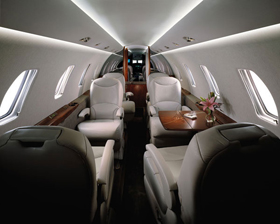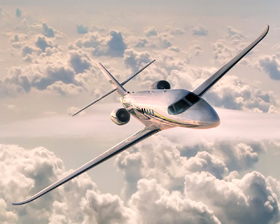Aircraft - Cessna Citation II
 COUNTRY OF ORIGIN
COUNTRY OF ORIGINUnited States of America
TYPE
Light corporate jets
GENERAL INFORMATION
The highly popular Cessna 500 Citation and 500 Citation I pioneered the entry level light business jet market, and their success formed the basis for the world's largest family of corporate jets.Cessna became the first of the big three American manufacturers (Piper, Beech and Cessna) to develop a jet powered transport. In October 1968 Cessna announced its plans to build a new eight place jet powered business aircraft that would be capable of operating into airfields already served by light and medium twins. Dubbed the Fanjet 500, the prototype flew for the first time on September 15 1969. Soon after the new little jet was named the Citation.
A relatively long development program followed, during which time a number of key changes were made to the design including a longer forward fuselage, repositioned engine nacelles, greater tail area and added dihedral to the horizontal tail. In this definitive form the Citation was granted FAA certification on September 9 1971.
 Improvements including higher gross weights and thrust reversers were added to the line in early 1976, followed shortly after by the introduction of the enhanced Citation I later that same year. Features of the Citation I were higher weights, JT15D-1A engines and an increased span wing. A further model to appear was the 501 Citation I/SP, which is certificated for single pilot
operation. The I/SP was delivered in early 1977.
Improvements including higher gross weights and thrust reversers were added to the line in early 1976, followed shortly after by the introduction of the enhanced Citation I later that same year. Features of the Citation I were higher weights, JT15D-1A engines and an increased span wing. A further model to appear was the 501 Citation I/SP, which is certificated for single pilot
operation. The I/SP was delivered in early 1977.PERFORMANCE
Citation - Max speed 647km/h (350kt), max cruising speed 644km/h (348kt). Initial rate of climb 3350ft/min. Service ceiling 38,400ft. Range with eight people on board and reserves at high speed cruise 2250km (1215nm). Citation I - Cruising speed 662km/h (357kt). Initial rate of climb 2720ft/min. Range with max fuel, 710kg (1560lb) payload and reserves 2460km (1328nm).
CAPACITY
Two pilots for Citation and Citation I, single pilot for Citation I/SP. Optional main cabin layouts for five, six or seven passengers.

